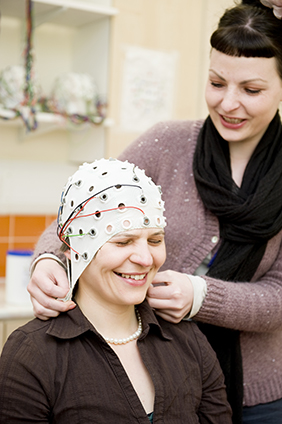Research Aims

Our research at the Brain and Behaviour Lab aims to gain new insights into the information processing stages involved in face recognition. This is achieved by combining behavioural and ERP markers of face-specific processing stages in typical adults and in adults with face recognition problems such as prosopagnosia. We can use our knowledge of the time-course of face processing stages in typical adults to address which face processing stages are impaired in prosopagnosia.
Some of our main research questions include: Do people with prosopagnosia have the same face-selective neural systems that are found in the general population? Do face and object recognition use different neural mechanisms? Do people with prosopagnosia see faces in the same way as neurotypical individuals? Is the face recognition impairment purely memory-related? Are the neural systems for emotion recognition the same in prosopagnosia as in the general population? Can we find neural evidence that prosopagnosics are able to store some information about face identity – even if only unconsciously?
Behavioural Testing
When participants visit our lab, we begin our testing with some behavioural experiments which are divided into two separate sessions. The behavioural tests assess different aspects of face and object processing such as face perception, face memory, gender discrimination, emotion processing or object recognition.
Participants are presented with images of faces and objects and asked to make decisions about what they see. For example, to decide whether items have been seen before, or to sort faces by similarity. One testing session lasts for approximately one to two hours. There are no risks or discomforts associated with participation. Results are collected and stored in accordance with the Data Protection Act. All test results are confidential and will not be made available to anyone else. If these results are published, participant’s identity will not be revealed.
Participants identified as having face processing deficits in our behavioural tests are then invited back to take part in our EEG testing.
EEG Testing
In an EEG testing session you will be required to wear an EEG (electroencephalogram) cap on your head. Once the cap is placed, we rub conductive gel onto your scalp to ensure that the sensors will pick up a good signal from your brain. Up to an hour is needed to put the cap on and to ensure that a good measurement is possible. After testing you will want to wash the conductive gel from your hair. We have a hand-held shower, clean towels, hair-care products, etc. for you to use. It is important to be well-rested when you take part in an EEG experiment. Also, it helps if you do not use any hair-care products like conditioner, oils or wax in your hair. Finally, if you wear contact lenses but also have a pair of glasses, it is advisable to bring them as some participants find that they get dry eyes when staring at a computer monitor for long periods of time.
The testing itself will take around an hour but may be longer depending upon the length of the breaks taken. During this time you will watch images on a computer monitor and perform a task by pressing buttons on a keypad. For example, ‘Are these two faces the same or different?’ This procedure will allow us to measure the electrical activity generated by neurons in your brain while you perform various face perception and recognition tasks. The entire procedure will take between two and three hours. Information about the results of experiments will be made available once studies are published in scientific journals.
